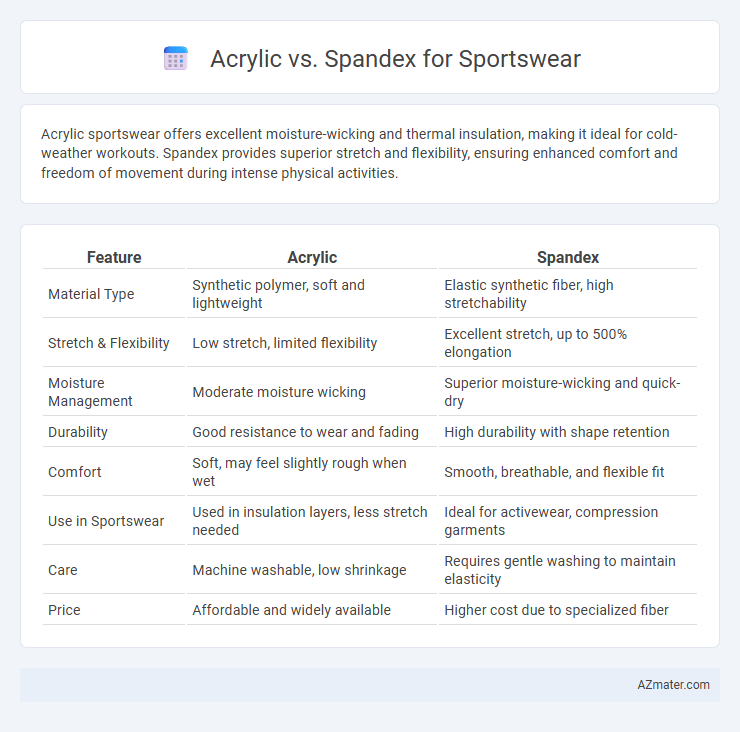Acrylic sportswear offers excellent moisture-wicking and thermal insulation, making it ideal for cold-weather workouts. Spandex provides superior stretch and flexibility, ensuring enhanced comfort and freedom of movement during intense physical activities.
Table of Comparison
| Feature | Acrylic | Spandex |
|---|---|---|
| Material Type | Synthetic polymer, soft and lightweight | Elastic synthetic fiber, high stretchability |
| Stretch & Flexibility | Low stretch, limited flexibility | Excellent stretch, up to 500% elongation |
| Moisture Management | Moderate moisture wicking | Superior moisture-wicking and quick-dry |
| Durability | Good resistance to wear and fading | High durability with shape retention |
| Comfort | Soft, may feel slightly rough when wet | Smooth, breathable, and flexible fit |
| Use in Sportswear | Used in insulation layers, less stretch needed | Ideal for activewear, compression garments |
| Care | Machine washable, low shrinkage | Requires gentle washing to maintain elasticity |
| Price | Affordable and widely available | Higher cost due to specialized fiber |
Introduction to Acrylic and Spandex in Sportswear
Acrylic fibers in sportswear offer lightweight warmth, moisture resistance, and durability, making them ideal for activities in cooler conditions. Spandex provides superior elasticity and flexibility, allowing sportswear to contour to the body and support dynamic movement in high-intensity workouts. Combining these materials enhances comfort, breathability, and performance for diverse athletic activities.
Key Material Properties Compared
Acrylic fibers offer excellent moisture-wicking and insulation, making sportswear lightweight and warm, while spandex provides exceptional stretch and recovery, ensuring a snug fit and enhanced flexibility. Acrylic is more breathable and resistant to UV rays, but spandex excels in elasticity and durability under repeated movement. Selection depends on the desired balance between thermal regulation and stretch performance for activewear design.
Breathability and Moisture Management
Acrylic fibers offer moderate breathability but tend to retain moisture, making them less ideal for intense sports activities that require efficient sweat management. Spandex excels in moisture-wicking properties and provides superior stretch, promoting better airflow and quick drying during high-intensity workouts. Choosing spandex-based sportswear enhances comfort by maintaining dryness and supporting optimal body temperature regulation.
Comfort and Fit for Activewear
Acrylic offers a lightweight, breathable fabric that wicks moisture away from the skin, making it suitable for sportswear requiring warmth and ventilation. Spandex provides superior elasticity and stretch, ensuring a snug fit that moves with the body during intense physical activities, enhancing comfort and freedom of movement. Combining acrylic's moisture management with spandex's flexibility creates premium activewear optimized for both comfort and performance.
Stretch and Flexibility Performance
Spandex outperforms acrylic in stretch and flexibility performance, making it the preferred choice for sportswear requiring high elasticity and freedom of movement. Spandex can stretch up to 500% without losing shape, providing superior support and comfort during intense physical activities. Acrylic, while lightweight and moisture-wicking, lacks the high stretchability of spandex, resulting in less flexibility and potential restriction during dynamic sports movements.
Durability and Longevity in Sports Use
Acrylic fibers offer excellent resistance to wear and abrasion, making them highly durable for sportswear subjected to rigorous activities. Spandex provides superior elasticity and shape retention but may degrade faster under prolonged exposure to sweat and UV rays, impacting its longevity in sports use. Combining acrylic's durability with spandex's stretch often results in sportswear that balances long-lasting performance and comfort.
Care and Maintenance Requirements
Acrylic sportswear offers durability and moisture resistance but requires gentle washing in cold water to prevent fabric pilling and color fading. Spandex-based apparel demands careful handling with hand washing or a delicate machine cycle, avoiding high heat to maintain elasticity and prevent fiber breakdown. Both fabrics benefit from air drying and avoiding bleach or fabric softeners to prolong garment lifespan and maintain performance quality.
Cost and Value Considerations
Acrylic sportswear typically offers a lower initial cost compared to spandex, making it a budget-friendly choice for casual athletic wear. Spandex, though more expensive, provides superior stretch, durability, and moisture-wicking properties, enhancing performance and long-term value in high-intensity sports. Evaluating cost alongside these functional benefits helps athletes and consumers select apparel that balances affordability with quality and comfort.
Environmental Impact and Sustainability
Acrylic sportswear, derived from petroleum-based fibers, presents a higher environmental footprint due to its non-biodegradable nature and reliance on fossil fuels. Spandex, although synthetic and energy-intensive to produce, often incorporates recycled materials and offers durability that supports longer garment life, reducing overall waste. Sustainable sportswear prioritizes recycled spandex blends and natural fiber alternatives to minimize ecological damage and enhance biodegradability.
Choosing the Right Fabric for Your Sport
Acrylic offers excellent moisture-wicking and durability, making it suitable for outdoor sports in cooler weather, while spandex provides superior elasticity and flexibility, ideal for high-movement activities like yoga and running. Selecting the right fabric depends on the specific demands of the sport; acrylic supports insulation and breathability, whereas spandex enhances freedom of movement and comfort. Prioritize performance features such as stretch, moisture management, and durability to match your sport's intensity and environmental conditions.

Infographic: Acrylic vs Spandex for Sportswear
 azmater.com
azmater.com